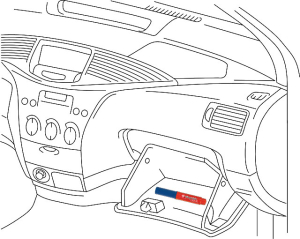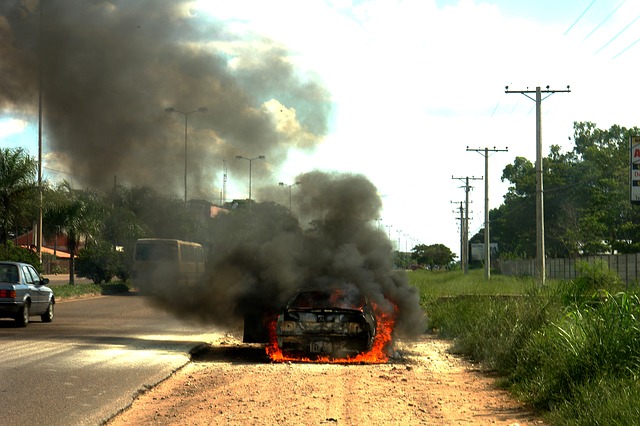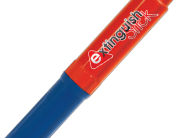The National Fire Protection Association (NFPA) reports that in 2014 there were 193,500 vehicle fires. These fires resulted in 345 deaths and 1,450 injuries. Some of the main causes cited for these fires include: poor vehicle maintenance, car crashes, hybrid and electric vehicle batteries, overheating catalytic converters, overheating engines, spilled fuels, electrical system failures, and fuel system leaks. Understanding what triggers these outcomes can better help you prevent a fire from occurring in your vehicle.
Poor Vehicle Maintenance
Preventative maintenance is crucial for your car’s survival. Your owner’s manual tells you how often you should get maintenance done. Neglecting to properly care for your vehicle can result in a spontaneous fire as a result of broken parts, leaky seals, or faulty wiring. Although regular vehicle maintenance can be a bit costly, it saves you a lot of money in the long term. It also has the potential to save your life and property.
Car Crashes
High impact vehicle collisions often result in fuel leaks within the vehicle’s engine. This ultimately results in the vehicle bursting into flames.
Hybrid and Electric Vehicle Batteries
All electric vehicle battery packs have several batter cells. Each cell contains a flammable liquid electrolyte. The most common type of battery used in electric vehicles is the lithium-ion battery. These batteries are capable of producing enough heat to fuel a fire. Electric car fires are, however, very rare. Manufacturers of electric cars and hybrid vehicles have put safety measures in place to slow the spread of a battery fire if one does occur. They’ve also put measures in place to save people within the vehicle if a fire does occur.
Overheating Catalytic Converters
Located in the car’s exhaust system, catalytic converters play the all-important role of converting harmful exhaust compounds into harmless compounds. The vigorous work that they do makes them prone to overheat. This is especially true when the car’s engine isn’t working efficiently. A poorly maintained engine results in a buildup of exhaust which puts more work on the catalytic converter. When the converter exceeds its normal temperature is can set the cabin insulation and carpeting on fire.
Spilled Fuels
Spilled fluids are one of the most common causes of car fires. There are a wide range of highly flammable and dangerous fluids in your vehicle: gasoline or diesel, engine oil, transmission fluid, power steering fluid, brake fluid, and engine coolant. If there is a knick in any of the hoses through which these fluids run, the likelihood of a fire occurring drastically increases.
Electrical System Failures
Electrical system failures rank high on the list of causes for car fires. Faulty of loose wiring in the vehicle’s engine can produce sparks that ignite the battery’s fluid or reacts with leaked gases. Electrical system failure is one of the most dangerous causes of car fires because the car’s electrical system runs throughout the entire vehicle.
Fuel System Leaks
Topping the list of causes of car fires is fuels system leaks. Some fuel leaks occur as a result of a damaged hose. Others happen spontaneously. Gasoline and diesel are highly flammable and can quickly ignite with just a single spark. This reaction is what occurs in the car’s engine every time you turn the ignition. However, that is a contained environment. If gasoline or diesel fuel were to fall on a hot metal or plastic part, disaster will strike.
Although regular vehicle maintenance can minimize the likelihood of your vehicle blowing up into flames, it is possible for a vehicle fire to occur unexpectedly. Being prepared is, therefore, vital. Ensure that your vehicle is equipped with a vehicle safety kit. One of the important components of your vehicle safe  ty kit is a compact fire extinguisher.
ty kit is a compact fire extinguisher.
Since car fires are usually either electrical or oil based, a Halotron I fire extinguisher is best for your vehicle. Halotron I fire extinguishers have been described as “clean agent” fire extinguishers because they leave no residue. They are, therefore, safer for vehicle parts than the dry powder fire extinguishers often recommended for vehicles. Halotron I is the chemical compound used in particular fire extinguishers. The compound is environmentally safe and is discharged as a rapidly evaporating liquid.
There are certain additional features that a car fire extinguisher should have. These additional features are:
- It should weigh less than 2 pounds.

- It should be elongated and cylindrical in shape.
- It should be made of aluminum.
- It should already be filled so that it can be used immediately.
- It should be easy to service.
- It should come with a storage clip or mount.
- It should have a long lasting and controlled trigger.
- It should have good warranty.
- It should be certified by your local authorities.
What Should You Do When Your Vehicle Catches Afire?
A vehicle fire can be a terrifying experience. It’s easy to panic and lose control of the situation. However, panicking can only lead to one unfortunate outcome: death. Being aware of the steps to take when a vehicle fire occurs can mean the difference between life and death. The following steps are recommended by the National Safety Council:
- Turn on your indicator and stop in a side lane or median so that you don’t obstruct traffic.
- Stop the vehicle and switch off the engine.
- Get out of the car as quickly as possible.
- If the fire is contained, attempt to use your car fire extinguisher to out the blaze. Ensure that you are standing at the recommended distance away from the fire. Trying to put out the blaze yourself is, however, usually not recommended.
- If the fire is out of control, move as far away from the vehicle as possible to avoid the flames and toxic fumes. One hundred feet is the recommended distance.
- Call emergency services.
Being aware of the causes of vehicle fires can help you put measures in place to prevent your vehicle from going up in smoke. However, it is possible that no matter what you do, a fire could occur. It is therefore crucial for you to have a well-stocked emergency vehicle safety kit. This kit should include a Halotron I fire extinguisher. Only use this extinguisher, however, if the fire is sufficiently contained. Otherwise, move as far away from the vehicle as possible.






Leave A Comment